NPE2024: The Plastics Show took place in Orlando, Florida, May 6-10, 2024, and Compressed Air Best Practices® Magazine and Chiller & Cooling Best Practices Magazine were there to cover the highlights. This year’s conference drew over 50,000 registrants, including 15,000 from outside the United States. Filling both buildings of the Orlando Convention Center, the conference included zones dedicated to bottling, recycling and sustainability, material science, advanced manufacturing, mold-making and packaging.
We focused on covering announcements in air compressors, chillers (low-global warming potential refrigerants were a hot topic), cooling towers, nitrogen generators and industrial vacuum systems.
Image courtesy of Oscar & Associates.
Air Compressors
ABC Compressors displayed its Horizon Synchro range of high-pressure, three-stage, oil-free, reciprocating air compressors. The line is built with a synchronous permanent magnet motor construction where the motor is directly attached to the compressor (no belts) to produce fewer vibrations with less wear on parts. “We’re standardizing variable speed drives (VSDs) for all of our units, but we’re not increasing the price because we’ve reduced the number of parts – the gear box and so on,” said Nacho Urbistondo, Business Development Manager. The soft starter VSD regulates voltage to eliminate a voltage spike at startup. System packages include a refrigerated high-pressure compressed air dryer. The line is capable of 70% turndown. Models range from 125 to 680-horsepower (hp) and up to 580 psi (40 bar). ABC claims a 5 to 7% efficiency gain over its own previous models, but 15 to 20% compared to the competition.

Nacho Urbistondo and Gonzalo Gabarain of ABC Compressors (left to right).
AF Compressors displayed its high-pressure PET range of three-stage, oil-free, reciprocating air compressors. At AF, the watchwords are “sober and efficient,” said Pascal Heyden, Sales and Marketing Manager. The phrase describes the company’s design philosophy of using only what’s needed and nothing more. Its three-stage design includes a vertical initial piston, and horizontal second- and third-stage pistons that require few valves. Its design philosophy translates into lower energy costs and maintenance costs. The low-speed PET range runs from 217 to 580 psi (15 to 40 bar). AF emphasizes the long life of its compressors, noting that one Egyptian oil refinery has been running the same AF air compressor since the 1980s.

Gareth Smith and Pascal Heyden of AF Compressors (left to right).
Alkin Compressors highlighted its ability to create custom air compressor solutions for bottling and injection molding customers. On display was a 527 series reciprocating air compressor in a cabinet that can be outfitted with sound insulation to decrease noise to 60 decibels. The display included a belt-driven, two-stage, air-cooled reciprocating air compressor with a booster able to output 175 cfm at 580 psi (40 bar). Alkin can multiplex compressors and boosters, with many customers running two compressors in parallel, but some running four in parallel for 700 cfm. “Our pumps are big. The form factor being bigger allows us to run a low RPMs,” said Nitin Shanbhag, President. “When a lot of people run at 1,800, 2,200 RPMs, we run between 650 and 1,100 RPMs. Aside from sound, it keeps things cooler and they last longer.”

Aydin Dereci, Nitin Shanbhag and Emre Tujumet of Alkin Compressor (left to right).
Atlas Copco Compressors discussed its air compressor options for a range of uses, emphasizing low-pressure rotary screw models for low-pressure installations and reciprocating models for high-pressure installations. When packaged with 300 to 400-hp compressed air boosters, the company can create solutions for even large bottling plants, optimizing different areas with different pressures. On display was a model from the company’s ZT line of oil-free rotary screw air compressors, capable of 51 to189 psi (3.5 to 13 bar), 42 to 5,210 cfm, and running at 20 to 1,207-hp. A two-stage air compressor, it included two airends and two motors. The display was a Full Featured model that included an integrated compressed air dryer. “You have the flexibility of regulating two motors, so you have a lot of turndown,” said Alfonso Peschiera, Vice President for High Pressure Products.
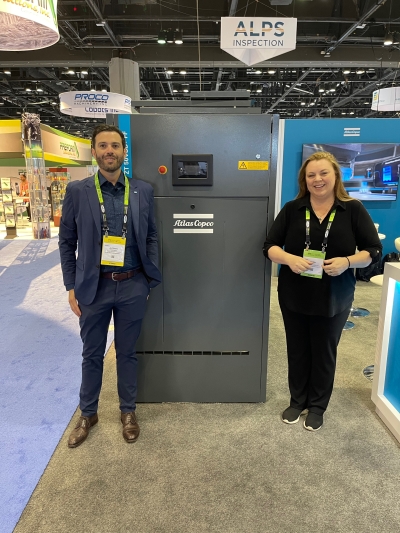
Alfonso Peschiera and Tammy Maynard of Atlas Copco (left to right).
Kaeser Compressors had multiple messages to communicate at its booth. Targeting small- to medium-sized specialty PET bottlers, it promoted its compact rotary screw air compressors. It displayed a 10-hp model, but noted it has solutions up to 700-hp. Noting the trend for creating separate air compressor enclosures outside a plant – whether because of a lack of floor space or hot or dusty conditions – the company also promoted its custom skid option. Kaeser engineers will work with customers to create built-to-order custom compressor rooms that are installed on site, no permits or architects needed. “We can basically create a compressor room that we build in Fredericksburg, put on the truck and deliver on site, and it has one power connection and one process connection,” said Michael Camber, Marketing Services Manager. Systems can be created at any size, from 5 to 450-hp. Kaeser has also created vacuum and blower enclosures, noting this is a popular option at wastewater treatment plants.
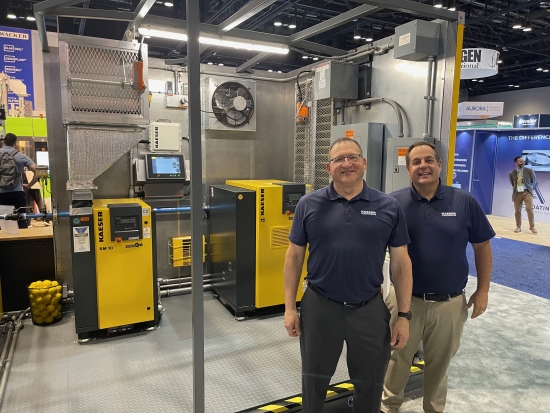
Michael Camber and Joe D’Orazio of Kaeser Compressors (left to right).
Nitrogen Generators
Bauer Compressors was having conversations with plastic injection molding companies about GIT, or gas injection technology. Rather than making parts out of solid resins, the company says, create a mold that injects inert nitrogen gas into the middle of the product. By doing so, manufacturers use less plastic material and the time to create each item is substantially reduced. Instead of cooling in the mold for two-and-a-half minutes, a gas-injected item might only take 40 seconds to cool. Nitrogen is an important component, as oxygen would burn and clog the injection molding machine’s injectors and valves. The company supplies system skids with air compressors and nitrogen generators that use either pressure swing adsorption or membrane systems.
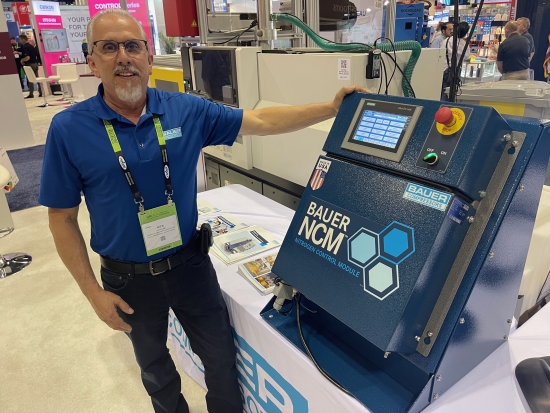
Rick Goralski of Bauer Compressors.
Chillers and Cooling Towers
Advantage Engineering, like many chiller manufacturers in attendance, reported having continual conversations about low-GWP refrigerants with visitors at NPE. Rather than moving to R-454b directly, for its central and modular chillers, the company is “slow-stepping it,” said President Jon Gunderson, transitioning customers to R-513a for the time being. Refrigerant compressors for chillers using R-454b are still in production, so this gives plants time to plan the safety requirements of the slightly flammable refrigerant. The company finds locating chillers outside is a growing trend for plastics manufacturers transitioning from hydraulic to electric-driven equipment, and have different cooling needs. Advantage Engineering provides offers outdoor chillers from 2 to 110-hp offering flow from 7.2 to 490 gpm.
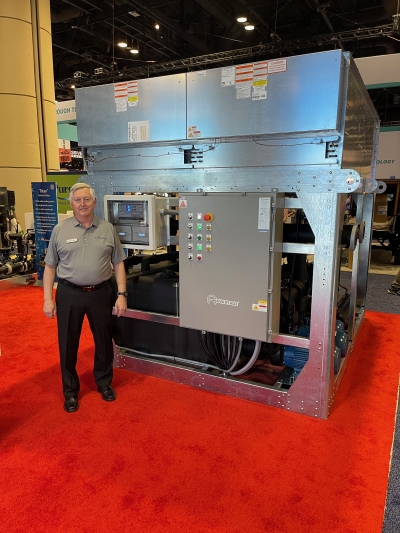
Jon Gunderson of Advantage Engineering.
AEC is helping customers move to low-GWP refrigerants with the release of two chiller lines using R-454b. The GPL series is on wheels so units can be moved around; they can be networked to provide 360 tons of cooling. The LHE series can be grouped together in connected bays to provide up to 600 tons of cooling. Since AEC was redesigning its chiller internals to accommodate new refrigerants, it upgraded their designs to make them more useful. The condenser for the LHE is on its side, compared to the older design, bringing the overall height down to 88 inches. The chiller is easier to service, with the manifold now easier to access, and includes a color touchscreen interface. The company added a leak detector for safety, as R-454b is rated as slightly flammable. “For us, it’s exciting because we fixed a lot of the problems we knew people complained about and now we have a better unit, and most importantly we have a product for customers who need R-454b,” said Bill Bruhn, Senior Product Manager.
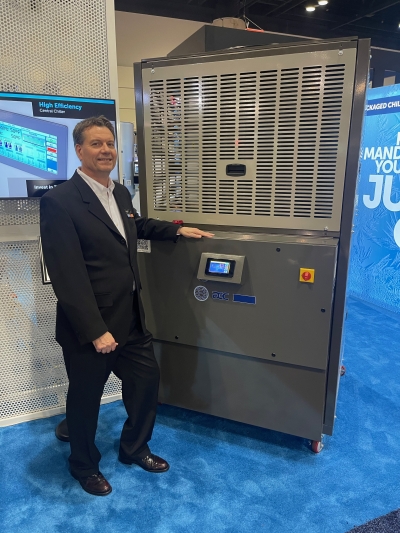
Bill Bruhn of AEC/ACS Group.
Chase Cooling Systems surprised attendees with a completely new product, the TGR Series of Thermochillers. Targeting injection-molding and other plastics processes, the TGR Series combines chilling and heating in one unit, with a water-cooled chiller, a three-way mixing valve and a heating resistor. It’s able to mix heat transfer fluids from the plant’s cooling hydronic system to achieve precise cooling control of +/-0.4°F. The series uses the low-GWP R-513a refrigerant. Eight models are available, from 8 to 60 kW, with cooling capacities from 2 to 17 tons. An integrated free-cooling mode lets the operator run directly from cooling tower output in the winter when temperatures are cold enough.
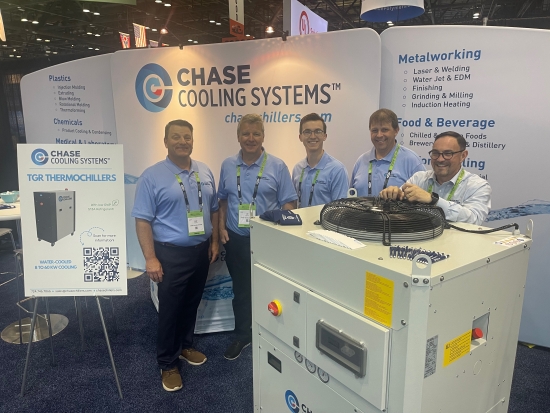
Chip Miller, Jim Miller, Spencer Miller, Phil Shaver and Massimiliano Parisi of Chase Cooling (left to right).
Frigel chillers were in abundance at NPE2024, used in many partners’ booths. At Frigel's own booth, the company displayed two new pieces of hardware. First up, the Microgel Syncro chiller promises smarter and more energy efficient cooling of plastic molds. Rather than chilling molds continuously during the molding process, as other chillers do, the Syncro senses when molds are open and closed, delivering super-chilled water during the closed portion only. When the mold is open, it passively heats up. “The big savings is the 30 to 40% improvement in cycle time,” said Al Fosco, Marketing Manager. The chiller also reduces failures that occur when plastic can’t fully form in an over-chilled mold. The company suggests buyers will see a return on investment in six to eight months. An included Syncro Wizard lets operators set up the unit in an hour. Next up, Frigel debuted the Ecodry 4DK, a cooling tower alternative with a closed water loop. The 4DK cools water through three stages, first by dry cooling, then with an adiabatic mode, finishing with a booster system that sprays water on cooling tubes. That sprayed water is collected and used in the adiabatic stage. The company cites a 20% energy efficiency improvement over the previous 3DK thanks to improved spray and fan designs.
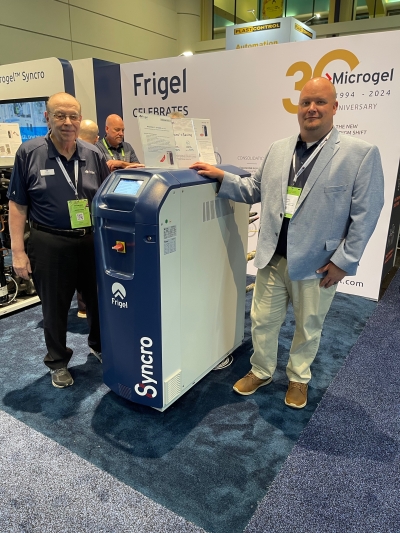
Al Fosco and Eric Thompson of Frigel (left to right).
Mokon was on hand to show its expanded Iceman LT Series of portable chillers, with LT standing for “low temperature.” The series now offers dual circuit capacities of 15 and 20 tons. It’s able to provide 300,200 BTU per hour at 20°F (-7°C) and 107,350 BTU per hour at -20°F (-29°C). The company offers both air-cooled and water-cooled options. Its unique design saves space and does away with the need for multiple electrical and mechanical connections. Most of the company’s orders are customized, with 90% of orders passing by the engineering team first to match process temperature control requirements, flow control requirement or other needs. “We don’t have a book,” said Key Account and Technical Sales Manager Scott Lombardo. “Everything’s its own unique animal.”
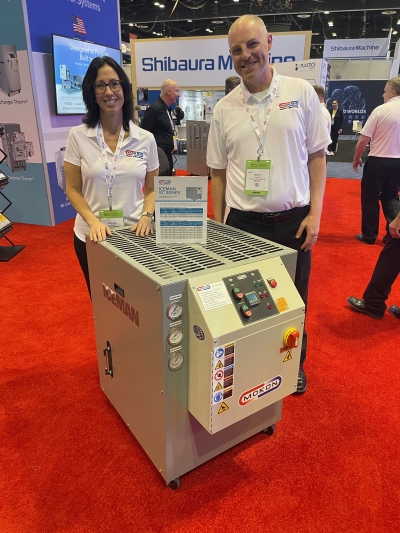
Roseann Leberer and Scott Lombardo of Mokon (left to right).
Process Cooling Systems stood out at NPE2024 not by wowing with new and improved hardware, but by selling its staff. No matter where in the U.S. a job is located, the company works exclusively with its own project management and installation crews, not third parties. Its employees are licensed in every state requiring a process piping license. While the company is listed as a manufacturer, it functions more as an engineering company, one devoted to never leaving customers unhappy.
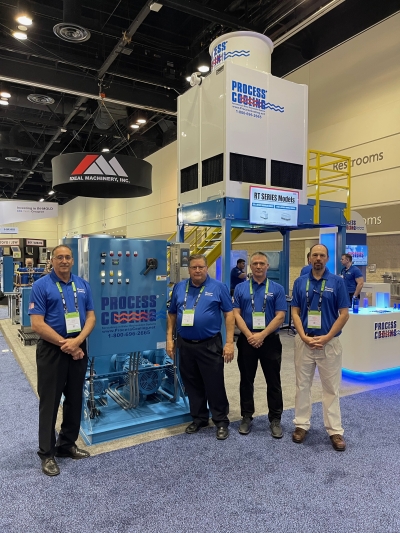
Dave Doucet, Ted Rudy, Shane Dandy and Derrek Davis of Process Cooling.
Thermal Care was among the many talking low-GWP refrigerants at NPE2024. It reengineered its entire line in a major undertaking that took years, so now all chillers use R-454b or R-513a refrigerants. For plastics manufacturers, the company showed its new Mini-Aquatherm RMC Series of temperature control units for plastic molding. The device is roughly half the size of the company’s Aquatherm RQT Series, and heats or cools water from 40°F to 250°F (4°C to 121°C) and comes with 1/3 or 1/2-hp pumps. The company is positioning the Mini-Aquatherm for small tonnage applications, below 100 tons. All equipment is constructed in the company’s 130,000-square-foot facility outside Chicago, Illinois.
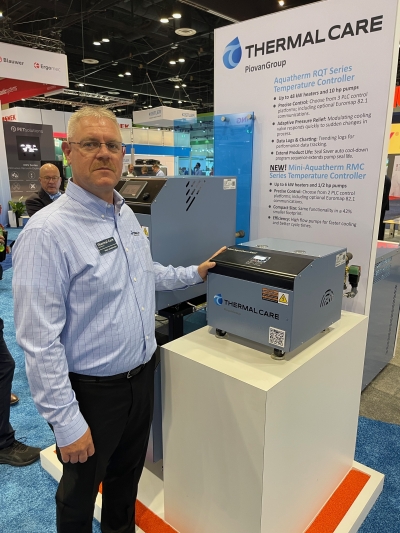
Peter Armbruster of Thermal Care.
Industrial Vacuum Systems
Busch Vacuum Solutions was excited to bring its PLASTEX series of dry vacuum systems to the U.S. market. Developed in Europe, PLASTEX offers the plastics extrusion market, or anyone else degassing their product, a vacuum system that doesn’t require water, but instead uses oil injection for cleaning. The system’s pump and filtration elements are kept separate. The company notes that PLASTEX units typically use MINK claw vacuum pumps, which offer frequency-controlled motors and are energy efficient.
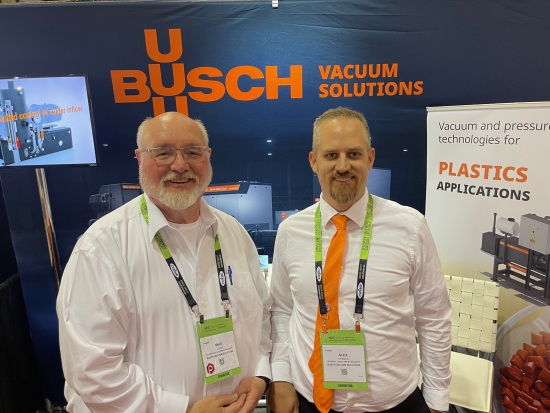
Mike Foster and Alex Hitsman of Busch Vacuum Solutions.
Conair was one of the few companies we saw discussing artificial intelligence. Its Conveying With Optimizer technology uses remote sensors to monitor conditions in plastic conveying, making adjustments automatically when needed. If a filter gets clogged or air leaks develop, the system adjusts on its own. Similarly, ResinWorks With Optimizer monitors how wet or dry materials are, saving energy by turning off heaters when they aren’t needed. “Taking the operator out of the equation, it’s doing all the adjustments,” said Stephen Szakelyhidi, Marketing Director.
Solberg Manufacturing made news at NPE2024 with its own line of vacuum system liquid/particulate separators, better known as knockout pots. With water conservation a necessity for many, these separators allow dry vacuum pumps to take the place of liquid rings. The company’s dual-filter system uses baffles and filters to remove liquid and particulates. The TKO Series features 2 to 8-inch inlet connection sizes, with 4-inches being the strongest mover. Separators are sized by flow and pipe size. “The great thing is Solberg is making these canisters,” said Andy Spicer, Regional Sales Manager. “We opened a fab shop and are making these in three buildings in Itasca, Illinois.” The plant employs 300 people, and new welders are always in demand.
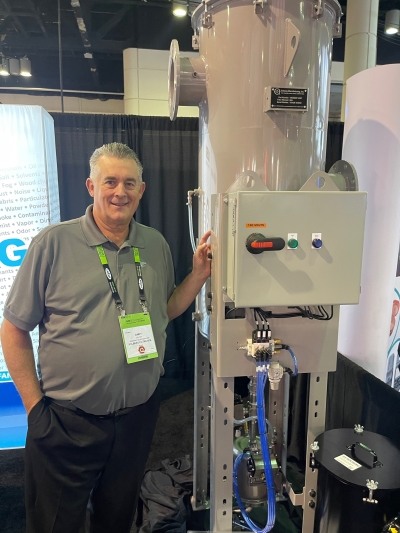
Andy Spicer of Solberg Manufacturing.
The plastics industry will meet again in three years at NPE2027, again in Orlando, Florida.
To read similar articles on the Plastics Industry please visit https://www.airbestpractices.com/industries/plastics.
Webinar Archive Section dedicated to Air Compressor Technology at https://www.airbestpractices.com/magazine/webinars.




